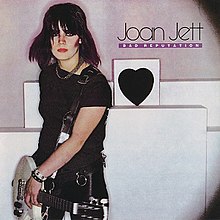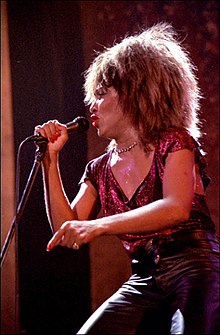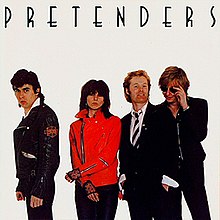« Vinyl Releases of the Week: October 26, 2011 | Home | Vinyl Releases of the Week: November 2, 2011 »
Top 10 Women in Rock
Post By: Katherine.Eleanor
Rock and roll has always been a male-dominated arena, but there’s no overemphasizing the great impact female rockers have had on the last 50 years of music. Here we acknowledge the women who not only paved the way for others by changing people’s expectations of women in rock and dismantling gender barriers, but who stretched the boundaries of the genre. They are easily some of the best artists of all time. Thankfully, compiling this list was not easy—there are way more than 10 incredibly talented and influential women in rock. So don’t be surprised if I post a Part II soon.
In no particular order:
 A pioneer of the 1970s New York punk scene, Patti Smith blended poetry and spoken word with noisy, three-chord rock and roll, earning a legacy as the “Godmother of Punk” and one of the greatest artists of all time. As influenced by ’60s garage rock as Arthur Rimbaud and French Symbolism, Smith fearlessly fused the intellectual with pure energy, and her deliberate primitivism and D.I.Y. aesthetic became tenants of the punk-rock movement. Smith released her debut, Horses, in 1975, and on the album she makes Them’s “Gloria” her own. Though her most well known song is “Because the Night,” a collaboration with Bruce Springsteen that appears on her 1978 album Easter, Smith often took a more free-form, avant-garde approach. Her unconventional music and uncompromising nature made her an icon for generations of rockers to come—from R.E.M.’s Michael Stipe to Garbage’s Shirley Manson. She is a true artist and a true inspiration.
A pioneer of the 1970s New York punk scene, Patti Smith blended poetry and spoken word with noisy, three-chord rock and roll, earning a legacy as the “Godmother of Punk” and one of the greatest artists of all time. As influenced by ’60s garage rock as Arthur Rimbaud and French Symbolism, Smith fearlessly fused the intellectual with pure energy, and her deliberate primitivism and D.I.Y. aesthetic became tenants of the punk-rock movement. Smith released her debut, Horses, in 1975, and on the album she makes Them’s “Gloria” her own. Though her most well known song is “Because the Night,” a collaboration with Bruce Springsteen that appears on her 1978 album Easter, Smith often took a more free-form, avant-garde approach. Her unconventional music and uncompromising nature made her an icon for generations of rockers to come—from R.E.M.’s Michael Stipe to Garbage’s Shirley Manson. She is a true artist and a true inspiration.
Must Have: Horses (1975).

Must Haves: Bad Reputation (1981), I Love Rock ‘n’ Roll (1981).
 Inspired by blues singers like Bessie Smith, Odetta, and Big Mama Thornton, and channeling the pain of her youth as an ostracized outcast in conservative Texas, Janis Joplin was one of the most vital singers to emerge in the late ’60s. She found refuge in San Francisco’s burgeoning psychedelic-rock scene where she fronted the band Big Brother and the Holding Company, recording the immortal song “Piece of My Heart” and the first rock album with a female lead singer in 1968’s Cheap Thrills. During her subsequent solo career, she recorded classics like “Try (Just a Little Bit Harder),” “Mercedes Benz,” “Me and Bobby McGee,” and “Cry Baby.” Joplin’s raspy voice, which wailed with passion and cracked with emotion, was completely uninhibited and stood in stark contrast to the expertly controlled pitch of many popular female singers of the day. While she may have only said to take another little piece of her heart, she gave the world a big piece of her soul and completely redefined the role of women in rock.
Inspired by blues singers like Bessie Smith, Odetta, and Big Mama Thornton, and channeling the pain of her youth as an ostracized outcast in conservative Texas, Janis Joplin was one of the most vital singers to emerge in the late ’60s. She found refuge in San Francisco’s burgeoning psychedelic-rock scene where she fronted the band Big Brother and the Holding Company, recording the immortal song “Piece of My Heart” and the first rock album with a female lead singer in 1968’s Cheap Thrills. During her subsequent solo career, she recorded classics like “Try (Just a Little Bit Harder),” “Mercedes Benz,” “Me and Bobby McGee,” and “Cry Baby.” Joplin’s raspy voice, which wailed with passion and cracked with emotion, was completely uninhibited and stood in stark contrast to the expertly controlled pitch of many popular female singers of the day. While she may have only said to take another little piece of her heart, she gave the world a big piece of her soul and completely redefined the role of women in rock.
Must Have: Pearl (1971).
 Crowned the “Queen of Rock and Roll” by Rolling Stone, as well as one of the greatest artists of all time, Tina Turner has not only inspired other women with the strength of her powerhouse vocals, her electrifying stage presence, and of her story of survival, she’s been a key influence to rock and roll heroes like the Rolling Stone’s Mick Jagger. Turner has been rocking out soul and R&B since the ’50s, getting her start as an 18-year-old backup singer in the Ike Turner Revue. Before long, she was the star of the show and kicking out classics like “River Deep, Mountain High” and “Proud Mary.” Then after divorcing Ike in 1978, Turner made an incredible comeback as a solo artist with her 1983 hit reading of Al Green’s “Let’s Stay Together” and 1984 album Private Dancer, which featured her only U.S. number-one hit, “What’s Love Got to Do with It.” Janet Jackson said it best with this: “Tina’s story is not one of victimhood but one of incredible triumph… In every sense, the woman has legs.”
Crowned the “Queen of Rock and Roll” by Rolling Stone, as well as one of the greatest artists of all time, Tina Turner has not only inspired other women with the strength of her powerhouse vocals, her electrifying stage presence, and of her story of survival, she’s been a key influence to rock and roll heroes like the Rolling Stone’s Mick Jagger. Turner has been rocking out soul and R&B since the ’50s, getting her start as an 18-year-old backup singer in the Ike Turner Revue. Before long, she was the star of the show and kicking out classics like “River Deep, Mountain High” and “Proud Mary.” Then after divorcing Ike in 1978, Turner made an incredible comeback as a solo artist with her 1983 hit reading of Al Green’s “Let’s Stay Together” and 1984 album Private Dancer, which featured her only U.S. number-one hit, “What’s Love Got to Do with It.” Janet Jackson said it best with this: “Tina’s story is not one of victimhood but one of incredible triumph… In every sense, the woman has legs.”
Must Have: Private Dancer (1984).
 Though she is known as the “Queen of Soul,” Aretha Franklin was the first woman inducted into the Rock and Roll Hall of Fame, and she indeed helped women gain some R-E-S-P-E-C-T in the industry. Getting her start singing gospel in her father’s Detroit church, Franklin is best known for her incredibly passionate voice, one that Mary J. Blige says is “the reason why women want to sing.” She is responsible for so many songs we know and love—”(You Make Me Feel Like) A Natural Woman,” “Respect,” “I Never Loved a Man (The Way I Love You),” “Think,” “Chain of Fools,” “Something He Can Feel”—and is still making history as the only singer at President Barack Obama’s 2009 Inauguration ceremony. Franklin taught herself how to play the piano at a young age and formed her own record label, Aretha’s Records, in 2005. She has remained a compelling presence in the music industry for the last 45 years, winning a total of 18 Grammys and enjoying success in each decade.
Though she is known as the “Queen of Soul,” Aretha Franklin was the first woman inducted into the Rock and Roll Hall of Fame, and she indeed helped women gain some R-E-S-P-E-C-T in the industry. Getting her start singing gospel in her father’s Detroit church, Franklin is best known for her incredibly passionate voice, one that Mary J. Blige says is “the reason why women want to sing.” She is responsible for so many songs we know and love—”(You Make Me Feel Like) A Natural Woman,” “Respect,” “I Never Loved a Man (The Way I Love You),” “Think,” “Chain of Fools,” “Something He Can Feel”—and is still making history as the only singer at President Barack Obama’s 2009 Inauguration ceremony. Franklin taught herself how to play the piano at a young age and formed her own record label, Aretha’s Records, in 2005. She has remained a compelling presence in the music industry for the last 45 years, winning a total of 18 Grammys and enjoying success in each decade.
Must Haves: I Never Loved a Man the Way I Love You (1967), Lady Soul (1968), Aretha Now (1968), Aretha Live at Fillmore West (1971), Young, Gifted and Black (1972), Amazing Grace (1972), Sparkle soundtrack (1976), Jump to It (1982), Who’s Zoomin’ Who? (1985), Aretha (1986), A Rose Is Still a Rose (1998).
 Stevie Nicks has quite a legacy. She’s rock’s mystical gypsy and one of the most legendary female singer-songwriters of the past four decades, influencing everyone from Debbie Harry to Melissa Etheridge and covered by everyone from Courtney Love to the Smashing Pumpkins. Her velvety, multidimensional voice leads many a classic-rock anthem. But she didn’t just sing songs like “Rhiannon,” “Dreams” (Fleetwood Mac’s only No. 1 single to date), and “Landslide”—she wrote them. This excellent songwriting along with her crystal vision brought a magical quality to Fleetwood Mac that catapulted the band to superstardom. Nicks is just as captivating on her solo rockers “Edge of Seventeen” and “Stand Back.” And 40 years on, she’s still rocking hard as an icon for women in rock and women in general.
Stevie Nicks has quite a legacy. She’s rock’s mystical gypsy and one of the most legendary female singer-songwriters of the past four decades, influencing everyone from Debbie Harry to Melissa Etheridge and covered by everyone from Courtney Love to the Smashing Pumpkins. Her velvety, multidimensional voice leads many a classic-rock anthem. But she didn’t just sing songs like “Rhiannon,” “Dreams” (Fleetwood Mac’s only No. 1 single to date), and “Landslide”—she wrote them. This excellent songwriting along with her crystal vision brought a magical quality to Fleetwood Mac that catapulted the band to superstardom. Nicks is just as captivating on her solo rockers “Edge of Seventeen” and “Stand Back.” And 40 years on, she’s still rocking hard as an icon for women in rock and women in general.
Must Haves: Fleetwood Mac (1975), Rumours (1977), Bella Donna (1981), The Wild Heart (1983).
 Debbie Harry was a trailblazer and a trendsetter who set the stage for a few other famous blondes (I’m talking about you, Madonna, Courtney Love, and Gwen Stefani!). Starting out waiting tables at Max’s Kansas City in 1970s punk-rock New York City, Harry was soon playing the iconic venue as the frontwoman of Blondie, one of the most influential and commercially successful new-wave bands to date. The blonde bombshell brought an ironic wit and sophisticated glamor to punk rock. In the late ’70s and early ’80s, Blondie helped reinvigorate rock and roll by blurring the lines between pop, punk, reggae, rap, and disco. The band enjoyed a string of hits that have withstood the test of time: “Heart of Glass,” “One Way or Another,” “Call Me,” “The Tide Is High,” and the first rap crossover hit, “Rapture.” Along with Pat Benetar, Harry was one of the first female frontwomen to utilize the music video. Through this medium, she influenced generations of female rockers by proving that women can be blonde, smart, sexy, and worthy of artistic respect.
Debbie Harry was a trailblazer and a trendsetter who set the stage for a few other famous blondes (I’m talking about you, Madonna, Courtney Love, and Gwen Stefani!). Starting out waiting tables at Max’s Kansas City in 1970s punk-rock New York City, Harry was soon playing the iconic venue as the frontwoman of Blondie, one of the most influential and commercially successful new-wave bands to date. The blonde bombshell brought an ironic wit and sophisticated glamor to punk rock. In the late ’70s and early ’80s, Blondie helped reinvigorate rock and roll by blurring the lines between pop, punk, reggae, rap, and disco. The band enjoyed a string of hits that have withstood the test of time: “Heart of Glass,” “One Way or Another,” “Call Me,” “The Tide Is High,” and the first rap crossover hit, “Rapture.” Along with Pat Benetar, Harry was one of the first female frontwomen to utilize the music video. Through this medium, she influenced generations of female rockers by proving that women can be blonde, smart, sexy, and worthy of artistic respect.
Must Haves: Parallel Lines (1978), Autoamerican (1980).
 As a kid in Akron, Ohio in the ’60s, Chrissie Hynde was enamored with rock bands. As a rock journalist writing for NME in London in the early ’70s, Hynde yearned to have her own rock band. As the tough but smoldering contralto singer, rhythm guitarist, and songwriter of the Pretenders, Hynde became a rock icon, breaking all conventional frontwoman stereotypes. The Pretenders’ eponymous 1979 debut album, which fused British Invasion-influenced rock, new wave, and punk, goes down as one of the greatest rock records of all time—its influence reaching even Neil Young and Crazy Horse. After the tragic deaths of two of the original Pretenders and decades of lineup changes, Hynde has soldiered on releasing nine studio albums and such classics as “Talk of the Town,” “Brass in Pocket,” “Back on the Chain Gang,” and “I’ll Stand By You.” This queen of rock is not pretending.
As a kid in Akron, Ohio in the ’60s, Chrissie Hynde was enamored with rock bands. As a rock journalist writing for NME in London in the early ’70s, Hynde yearned to have her own rock band. As the tough but smoldering contralto singer, rhythm guitarist, and songwriter of the Pretenders, Hynde became a rock icon, breaking all conventional frontwoman stereotypes. The Pretenders’ eponymous 1979 debut album, which fused British Invasion-influenced rock, new wave, and punk, goes down as one of the greatest rock records of all time—its influence reaching even Neil Young and Crazy Horse. After the tragic deaths of two of the original Pretenders and decades of lineup changes, Hynde has soldiered on releasing nine studio albums and such classics as “Talk of the Town,” “Brass in Pocket,” “Back on the Chain Gang,” and “I’ll Stand By You.” This queen of rock is not pretending.
Must Have: The Pretenders (1979), Pretenders II (1981).
 Pat Benatar was one of rock’s top vocalists in the ’80s. She brought substance to arena rock, storming the stage with her powerful pipes and tough sexuality. Hits like “Heartbreaker,” “Love Is a Battlefield, and “Hit Me With Your Best Shot” remain rock staples today. Even more significant is the way she filled the void of a frontwoman with hard-rock chops and a distinct sense of melody. This eventually took her in a more synthesized pop-rock direction, but Benatar remains one of the most no-nonsense female rock icons of the decade.
Pat Benatar was one of rock’s top vocalists in the ’80s. She brought substance to arena rock, storming the stage with her powerful pipes and tough sexuality. Hits like “Heartbreaker,” “Love Is a Battlefield, and “Hit Me With Your Best Shot” remain rock staples today. Even more significant is the way she filled the void of a frontwoman with hard-rock chops and a distinct sense of melody. This eventually took her in a more synthesized pop-rock direction, but Benatar remains one of the most no-nonsense female rock icons of the decade.
Must Haves: In the Heat of the Night (1979), Crimes of Passion (1980).
 As a songwriter, she is peerless; as a singer, she can be terrifying; as a musician, she is constantly challenging herself; as a result, this English country girl has created some of the most original rock music of my generation. Take for example her 1995 breakthrough, To Bring You My Love: opening with Harvey’s tortured groan and a snakey guitar, the album completely sucks you into her world of ugly-pretty. Harvey continues to challenge herself with each release, often learning a new instrument and then creating a whole album around it. Contrast the raw, bluesy feel of 1993’s Rid of Me with the intentionally nauseating electronics of 1998’s Is This Desire?, the gorgeously haunting piano of 2007’s White Chalk, or the folksy autoharp on this year’s Let England Shake. You’ll be astonished. But at the heart of Harvey’s varied yet impeccable discography is real, honest art with the power to be both intimidating and captivating. She is one of the most unique women in rock history.
As a songwriter, she is peerless; as a singer, she can be terrifying; as a musician, she is constantly challenging herself; as a result, this English country girl has created some of the most original rock music of my generation. Take for example her 1995 breakthrough, To Bring You My Love: opening with Harvey’s tortured groan and a snakey guitar, the album completely sucks you into her world of ugly-pretty. Harvey continues to challenge herself with each release, often learning a new instrument and then creating a whole album around it. Contrast the raw, bluesy feel of 1993’s Rid of Me with the intentionally nauseating electronics of 1998’s Is This Desire?, the gorgeously haunting piano of 2007’s White Chalk, or the folksy autoharp on this year’s Let England Shake. You’ll be astonished. But at the heart of Harvey’s varied yet impeccable discography is real, honest art with the power to be both intimidating and captivating. She is one of the most unique women in rock history.
Must Haves: To Bring You My Love (1995), Stories from the City, Stories from the Sea (2000), Let England Shake (2011).
I’d also like to give an honorable mention (and some serious props) to two of the most controversial women in rock:
 Not the greatest role model, but undeniably one of the most rebellious, out of control, and fascinating women in rock history. Rock is in her blood, and punk is in her bones. Trust me—I saw Love perform live with the reformed Hole last year and was blown away by how hard this grunge icon rocked onstage, some 15+ years after Hole released its landmark album, Live Through This. Love wasn’t afraid to challenge women’s role in society, she wasn’t afraid to tackle some pretty weighty female issues, and she wasn’t afraid to do whatever the hell it took to get noticed. She’s the ultimate musician, performer, and rocker—no matter how often she puts her foot in her mouth.
Not the greatest role model, but undeniably one of the most rebellious, out of control, and fascinating women in rock history. Rock is in her blood, and punk is in her bones. Trust me—I saw Love perform live with the reformed Hole last year and was blown away by how hard this grunge icon rocked onstage, some 15+ years after Hole released its landmark album, Live Through This. Love wasn’t afraid to challenge women’s role in society, she wasn’t afraid to tackle some pretty weighty female issues, and she wasn’t afraid to do whatever the hell it took to get noticed. She’s the ultimate musician, performer, and rocker—no matter how often she puts her foot in her mouth.
Must Have: Live Through This (1994).
 In the early ’90s, Sinead O’Connor was a highly political and controversial figure in rock. She challenged longstanding female stereotypes and, in turn, completely altered the image of women in rock. With her shaved head and shapeless clothes, she provided an alternative to the “sex sells” approach of pop stars like Madonna; and by asserting herself as a serious artist and not a sex object, she kick-started a revolution that paved the way for the likes of Liz Phair, Courtney Love, and Alanis Morissette. But all politics aside, this Irish artist’s songwriting is impeccable and her voice is extraordinary—one of the most distinctive in music. Her art-rocker “Mandinka” from her masterful debut, The Lion and the Cobra, is an incredible example of how her music was as bold as her actions. Nothing Compares 2 U, Sinead.
In the early ’90s, Sinead O’Connor was a highly political and controversial figure in rock. She challenged longstanding female stereotypes and, in turn, completely altered the image of women in rock. With her shaved head and shapeless clothes, she provided an alternative to the “sex sells” approach of pop stars like Madonna; and by asserting herself as a serious artist and not a sex object, she kick-started a revolution that paved the way for the likes of Liz Phair, Courtney Love, and Alanis Morissette. But all politics aside, this Irish artist’s songwriting is impeccable and her voice is extraordinary—one of the most distinctive in music. Her art-rocker “Mandinka” from her masterful debut, The Lion and the Cobra, is an incredible example of how her music was as bold as her actions. Nothing Compares 2 U, Sinead.
Must Haves: The Lion and the Cobra (1987), I Do Not Want What I Haven’t Got (1990).
Join the Conversation: Post a Comment!
Topics: Artist Tributes, Music, Record Collecting, Rock | No Comments »


